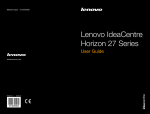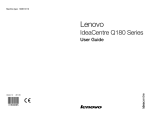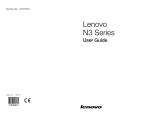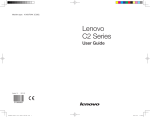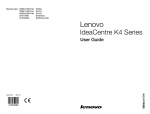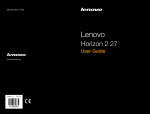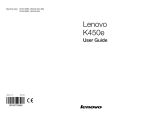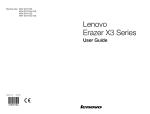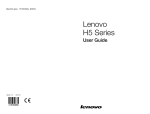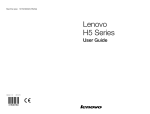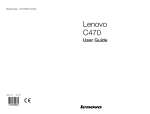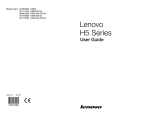Download Lenovo IdeaCentre Q190
Transcript
Machine type: 10115/6281 Lenovo IdeaCentre Q190 Series User Guide Version 1.0 2012.09 31502991 Important Safety Information Before using this manual, it is important that you read and understand all of the related safety information for this product. Refer to the Safety and Warranty Guide that you received with this product for the latest safety information. Reading and understanding this safety information reduces the risk of personal injury or product damage. The interface and functions shown in this User Guide are provided for reference only and may differ from actual product appearance. Product design and specifications may be changed without notice. Danger: Be aware of extremely hazardous or potentially lethal situations. Attention: Be aware of possible damage to programs, devices, or data. Note: Pay attention to this important information. © Copyright Lenovo 2012. All rights reserved. LIMITED AND RESTRICTED RIGHTS NOTICE: If data or software is delivered pursuant a General Services Administration “GSA” contract, use, reproduction, or disclosure is subject to restrictions set forth in Contract No. GS-35F-05925. Contents Important Safety Information Using the Computer Hardware.................................................. 1 Front view...................................................................................................2 Rear view....................................................................................................3 Basic connector instructions.......................................................................4 Computer stand instruction.........................................................................5 Connecting your computer..........................................................................6 Display connecting instructions when playing Blu-ray Discs.........................7 Connecting to the Internet...........................................................................8 Setting the display resolution.......................................................................9 Using S/P DIF output digital signals.............................................................9 Wired keyboard (selected models only).....................................................10 Using Windows 8....................................................................... 11 Switching between the main Windows 8 interfaces...................................12 The Charms Bar........................................................................................12 Shutting down the computer.....................................................................12 Switching between apps...........................................................................13 Closing an app..........................................................................................13 Opening other system programs...............................................................13 Windows Help and Support......................................................................13 Using the Rescue System......................................................... 15 OneKey Recovery.....................................................................................16 Driver and Application Installation..............................................................17 Using the Software.................................................................... 19 Lenovo Support........................................................................................20 Contents i Troubleshooting and Confirming Setup.................................. 21 Troubleshooting display problems.............................................................22 Troubleshooting audio problems................................................................23 Troubleshooting software problems...........................................................24 Troubleshooting problems with Hard Disks................................................25 Special considerations for troubleshooting Windows.................................25 Windows Help and Support......................................................................26 BIOS setup utility.......................................................................................26 Performing Daily Maintenance Tasks.........................................................27 Appendix.................................................................................... 29 Declaration................................................................................................29 Trademarks...............................................................................................30 Energy Star Statement..............................................................................31 Enabling ErP compliance mode.................................................................32 ii Contents Using the Computer Hardware This chapter contains the following topics: Introduction to the computer hardware Information on computer connections Note: The descriptions in this chapter might be different from what you see on your computer, depending on the computer model and configuration. User Guide 1 Front view Attention: Ensure that none of the air vents on the computer are blocked. Blocked air vents can lead to overheating problems. Eject button Power button Hard disk drive indicator Optical drive (selected models only) Memory card reader USB ports (2) Headphone connector Microphone connector Attention: Do not insert 3-inch discs into the optical drive. 2 User Guide Rear view S/P DIF port VGA connector USB ports (5) HDMI-out port Ethernet connector Power connector User Guide 3 Basic connector instructions Note: Your computer may not have all of the connectors described in this section. Connector Description Microphone Use this connector to attach a microphone to your computer when you want to record sound or if you use speech-recognition software. Headphone Use this connector to attach headphones to your computer when you want to listen to music or other sounds without disturbing anyone. USB connector Use this connector to attach a device that requires a USB connection. Memory card reader Use to view and share digital photos, music, and videos, stored on a media card. Ethernet connector Use this connector to attach the computer to an Ethernet-typelocal area network. VGA connector Used to attach a VGA monitor or other devices that use a VGA monitor connector. HDMI connector (optional) Connect to the HDMI connector on your display or TV. Power connector Connect to the power cable. The appearance of this connector may vary. Note: If your computer is equipped with a wireless keyboard or mouse, follow the installation instructions for those devices. 4 User Guide Computer stand instruction 1 2 User Guide 5 Connecting your computer Connecting the power cord Connect the power cord to an electrical outlet. We recommend using a grounded connection or a surge protector. Press the power button 6 User Guide Display connecting instructions when playing Blu-ray Discs Note: Only some models are equipped with Blu-ray optical drive. Check the connectors available on your computer and display and select an appropriate cable according to the table below. Other types of cables do not meet the requirements of the Blu-ray standard. You need to purchase the cable separately if the computer is not equipped with the corresponding cable. This table will help you to identify the connectors on your computer and display. Connection Type Computer Cable Display DVI to DVI (DVI cable) DVI to HDMI (DVI-HDMI cable) HDMI to HDMI (HDMI cable) HDMI to DVI (HDMI-DVI cable) User Guide 7 Connecting to the Internet To connect to the Internet, you’ll need a contract with an Internet Service Provider (ISP) and some hardware. IPSs and ISP offerings vary by country. Contact your ISP for offerings available in your country. Your computer is designed to support a wireless (selected models only) or wired network that connects your computer to other devices. Wired network connection For wired networks, connect one end of an Ethernet cable (purchased separately) to the Ethernet connector on your computer, and then connect the other end to the network router or broadband modem. Consult your ISP for detailed setup instructions. Note: Broadband modem and router installation procedures vary depending on the manufacturer. Follow the manufacturer’s instructions. Wireless network connection For wireless networks, you can use the built-in wireless LAN antenna to access your wireless home network. To connect your computer to the wireless network: 1. Move the cursor to the top right or bottom right corner of the screen, then click Settings. (If your computer is equipped with touch screen, swipe in from the right edge of the screen, then tap Settings.) , then select the name of your router. Click or 2. Click or tap the network icon tap Connect, then follow the steps on the screen. Test the wireless network by opening your Web browser and accessing any Web site. 8 User Guide Setting the display resolution • Set the refresh rate of your TV or monitor to less than 60 Hz to avoid damage to your TV or monitor. • If no image is displayed on the TV or monitor after setting a new refresh rate, turn off your TV or monitor and wait for a moment before restarting. • When connecting to a TV, please select the TV’s appropriate input channel. • Lenovo recommends connecting the computer to a monitor using the VGA or HDMI video connector. • It is possible to connect the computer to a TV using the VGA or HDMI video connector, but Lenovo is unable to guarantee that this will work effectively. After the computer is connected and is operating normally, if a blank screen or no image is displayed on the TV, this may be a problem with the TV settings. Please consult with your TV supplier. Using S/P DIF output digital signals If you have external devices that support S/P DIF, you can use the S/P DIF port output high definition audio signal. Do the following before using S/P DIF output: 1. Connect the external device to the S/P DIF port. 2. From the Control Panel, select Hardware and Sound → Manage audio devices, from the pop up window choose the Playback tab, choose Digital Audio (S/P DIF) as your playback device, click the Apply button to save the change. Note: You may find your computer has no sound if you switch to a different external device that dose not support S/P DIF, follow step 2 to choose a proper playback device. User Guide 9 Wired keyboard (selected models only) LVT ——After entering Windows, press this key to launch the LVT (Lenovo Vantage Technology) program, Lenovo’s pre-loaded Home PC software. In addition to its own functions, the LVT program will allow you to start other Windows compatible software specially configured to run on this model of computer. Notes: • Some models are not equipped with the LVT program. • The LVT key on the keyboard is disabled in the models without the LVT program. F2 ——Your computer has the Lenovo Rescue System installed. To learn more about this program, repeatedly press and release the F2 key once turning on the computer until the Lenovo Rescue System opens. 10 User Guide Using Windows 8 This chapter contains the following topics: Switching between the main Windows 8 interfaces The Charms Bar Shutting down the computer Switching between apps Closing an app Opening other system programs Windows Help and Support Attention: The Windows 8 operating system is provided by Microsoft Corporation. Please use it in accordance with the END USER LICENSE AGREEMENT (EULA) between you and Microsoft. For any question related to the operating system, please contact Microsoft directly. User Guide 11 Switching between the main Windows 8 interfaces Windows 8 comes with two main user interfaces: the Start Screen and the Windows desktop. To switch from the Start Screen to the Windows desktop, do one of the following: • Select the Windows desktop tile on the Start Screen. + D. • Press the Windows key To switch from the desktop to the Start Screen, do one of the following: • Select Start from the Charms Bar. • Move the cursor to the bottom left corner, then select the Start Screen thumbnail when it is displayed. • Press the Windows key . The Charms Bar Charms provide new and faster ways to perform many basic tasks. To display the charms, do one of the following: • Move the cursor to the top right or bottom right corner of the screen. • If your computer is equipped with touch screen, swipe in from the right edge of the screen. • Press the Windows key + C. Shutting down the computer To shut down the computer: 1. Move the cursor to the top right or bottom right corner of the screen, then click Settings. (If your computer is equipped with touch screen, swipe in from the right edge of the screen, then tap Settings.) 2. Select Power → Shutdown. 12 User Guide Switching between apps Sometimes you want to get back to an app you were just using, or quickly switch through your recent apps. To switch between apps: Move the cursor to the top left corner, then click to bring in the next app. (If your computer is equipped with touch screen, swipe in from the left edge of the screen to bring in the next app.) Closing an app To close an app, do one of the following: • Move the cursor to the top left corner of the screen. When the thumbnail appears, drag it to the bottom of the screen. • Move the cursor to the top edge of the screen. When the cursor becomes a hand, drag the app page to the bottom of the screen. • If your computer is equipped with touch screen, swipe in from the top edge of the screen. When the app page becomes smaller, drag it to the bottom of the screen. Opening other system programs There is a fast way to open other system programs. To open the menu, do one of the following: • Move the cursor to the bottom left corner of the screen. When the thumbnail appears, right-click with the mouse to open the menu. • Press the Windows key + X. Windows Help and Support If you have a problem with the operating system, see the Windows Help and Support file. To open the Windows Help and Support file, do one of the following: • Select the Settings charm, then select Help. • Press the Windows key + F1. You can read the Windows Help and Support file on your computer. You can also get online help and support by clicking on one of the two links listed under More to explore. User Guide 13 14 User Guide Using the Rescue System This chapter contains the following topics: OneKey Recovery Driver and Application Installation Attention: Using OneKey Recovery will result in loss of data. • You can restore the C: drive of the computer to factory default settings or to the last system backup status using OneKey Recovery. If you do this, all of the existing data on drive C: will be lost, but the content and format of the other partitions of the hard disk drive will remain unchanged. • If you want to install an operating system and back it up with OneKey Recovery, you must format the C: partition in NTFS format and install the operating system on the C: partition. Otherwise, the OneKey Recovery system cannot run. User Guide 15 Note about the service partition: The files and relevant data used by the rescue system are saved in the service partition. Deleting this partition will make the rescue system unusable. For more detailed information, see the following instructions: From the Search charm, select Apps → Control Panel → Administrative Tools → Computer Management → Disk Management, you can see the service partition, which must not be deleted. Note: The recovery files and relevant data used by the rescue system are saved in the service partition. If the service partition is deleted or damaged by someone other than authorized Lenovo service personnel, Lenovo will not be liable for any losses arising therefrom in any way. OneKey Recovery OneKey Recovery is an easy-to-use application. You can use it to restore your computer to the system default or to a previously backed up state. Detailed Operation Procedure 1. Repeatedly press and release the F2 key once turning on the computer until the Lenovo Rescue System opens, then select OneKey Recovery. Note: System Recovery will overwrite all of the data on the C: drive. To prevent loss of data, be sure to back up relevant data before performing system recovery. 2. Follow the on-screen instructions to select the backup task you want to restore from and the disk where you want to install the operating system, then press Next to start the restore. 3. Please wait during the process of system recovery. Do not interrupt the operation during the recovery process. 4. After the system is recovered successfully, the software will prompt you to restart the computer. Restart the computer and start the operating system. 16 User Guide Driver and Application Installation The Driver and Application Installation function in the rescue system provides a way for the user to conveniently reinstall all of the Lenovo applications and drivers that were shipped with your Lenovo hardware. Method 1: Automatic Installation Repeatedly press and release the F2 key once turning on the computer until the Lenovo Rescue System opens, then select Drivers and Application Installation. Follow the on-screen prompts to install the Lenovo drivers and applications. Click OK to start installing the Lenovo Drivers and Application Installation software. The system will restart. After the system has restarted, the drivers and application installation process will continue until it has completed. Method 2: Manual Installation In the Windows system, Select Driver and Application Installation from the Search charm. After starting the procedure, install the drivers and software manually by following the prompts. Notes: 1. Do not install software which is already installed on the computer. 2. Make sure that the Drivers and Application Installation software has been automatically installed before starting the operating system. The manual installation function can only be used after the software has been installed. User Guide 17 18 User Guide Using the Software This chapter contains the following topic: Software instructions Note: The interface and functionality of these features will depend on which software was shipped with the computer model you purchased. User Guide 19 Lenovo Support The Lenovo Support program enables you to register your computer with Lenovo, download and view user manuals for your computer, get the warranty information of your computer, and explore help and support information. To open this program, do the following: Click the Lenovo Support icon from the Start Screen or Search Screen. The main functions of this program are listed below. (This program supports online upgrades. The functions shown below are for reference only, functionality will depend on the program icons currently displayed.) Registration Registration provides you with access to product support, upgrades and alerts on topics. Take advantage of award-winning Lenovo services. User Guide The User Guide provides more information about your computer. Service and Warranty You can extend the warranty of your computer through this option. Lenovo provides flexible options to meet your personal or business needs. 20 User Guide Troubleshooting and Confirming Setup This chapter contains the following topic: Troubleshooting and Problem Resolution User Guide 21 Solving problems Follow these tips when you troubleshoot your computer: • If you added or removed a part before the problem started, review the installation procedures and ensure that the part is correctly installed. • If a peripheral device does not work, ensure that the device is properly connected. • If an error message appears on the screen, write down the exact message. This message may help support personnel diagnose and fix the problem(s). • If an error message occurs in a program, see the Help document of this program. Troubleshooting display problems Problem: Blank screen or no image is displayed on the monitor. Troubleshooting and problem resolution: 1. Check that the monitor has been turned on; if not, press the Power button. 2. Check to see if the monitor power cable is loose; if so, securely plug the power cable into the monitor. 3. Check that the signal cable to the monitor is securely connected to the computer graphics card port; if not, shut down the computer then securely connect the signal cable of the monitor. Problem: You need to change the display property settings. Setting display background and icon properties: 1. Right-click the desktop anywhere except over an icon, then select Personalize from the pop-up menu. 2. From here, select the appropriate options to: • Change the desktop background • Select a screen saver • Select Windows color options for borders and taskbar • Select a themes 3. Right-click the desktop anywhere except over an icon, then select Screen resolution from the pop-up menu to change the resolution of your TV or monitor. If your TV or monitor does not support this new resolution, the system will recovery to the original resolution within 20 seconds. 22 User Guide Set the refresh rate of your TV or monitor to less than 60 Hz to avoid damage to your TV or monitor. If there is no image displayed on the TV or monitor after setting a new refresh rate, turn off your TV or monitor and wait for a moment before restarting. For TV, you may switch the input style to another and then switch it back to make your TV display normally. Problem: Ripple on screen. Troubleshooting and problem resolution: 1. Check for devices located less than one meter from the computer such as refrigerators, electric fans, electric dryers, UPSs, regulators, fluorescent lamps or other computers that may be generating magnetic interference. 2. Move any interfering devices away from the computer. 3. If the problem persists, consult your display devices supplier. Troubleshooting audio problems Problem: No sound from the integrated speakers. Troubleshooting and problem resolution: • Adjust the Windows volume control — select the speaker icon from the Settings Charm or click the arrow on taskbar to show the hidden icons in Windows desktop mode, then click the speaker icon. Ensure that the volume is turned up and that the sound is not muted. Adjust the volume, bass, and treble controls to eliminate distortion. • Reinstall the audio driver. • Disconnect any headphones from the headphone socket — sound from the speakers is automatically disabled when headphones are connected to the computer’s side-panel headphone socket. • Remove and reconnect the HDMI connector, restart the computer, and set the HDMI as the audio output mode (for example via the control panel). Note: IdeaCentre Q190 supports HDMI audio and video output. To learn more about HDMI, go to the web site at: http://www.hdmi.com/ Problem: No sound from headphones. Troubleshooting and problem resolution: • Check the headphone cable connection — ensure that the headphone cable is securely inserted into the headphone socket. User Guide 23 • Adjust the Windows volume control — select the speaker icon from the Settings Charm or click the arrow on taskbar to show the hidden icons in Windows desktop mode, then click the speaker icon. Ensure that the volume is turned up and that the sound is not muted. • Change audio device — from the Control Panel, select Hardware and Sound → Manage audio devices, a sound window will pop out, click the playback tab to choose the proper playback device. Troubleshooting software problems Problem: You are unable exit a running program normally. Troubleshooting and problem resolution: 1. Press the Ctrl, Alt and Delete keys at the same time, then select the Task Manager option from the pop up window. 2. Select the problem program, then click the End Task button. Problem: You need to install or uninstall a program. Problem resolution: During installation never abort the install process by powering the system off or through other drastic means. This can cause system program problems or even failure during system initialization. During the uninstall process, never directly delete individual files or folders. This is harmful to the operating system, and might cause a system-wide malfunction. Use the following procedure to properly uninstall programs: 1. Back up all documents and system settings related to the program before removing it. 2. If the program has its own uninstaller, run it directly to uninstall the program. 3. If the program does not have its own uninstaller, then select Apps → Control Panel from the Search charm. 4. From the Control Panel, choose Programs → Programs and Features. 5. Find the applicable program from the Programs and Features dialog box and then select Uninstall/Change. 6. Perform the instructions displayed to uninstall the software. 24 User Guide Troubleshooting problems with Hard Disks Problem: The capacity of the hard disk, as indicated by the system, is less than the nominal capacity. Troubleshooting and problem resolution: For computers equipped with the OneKey Recovery feature, the system recovery feature needs to occupy some hard disk space. This may account for the apparent hard disk capacity deficit. Further Technical Explanation: The nominal capacity of the hard disk is expressed in the decimal system, 1000 bytes. But the actual hard disk capacity is expressed in the binary system as 1024 bytes (For example, a nominal capacity of 1GB is 1000MB, while the actual capacity of 1GB is 1024MB). The capacity of the hard disk shown in Windows can be worked out according to the calculations in the following example: The nominal capacity of the hard disk is 40GB, while its actual capacity should be: 40 x 1000 x 1000 x 1000/(1024 x 1024 x 1024) = 37GB. If the Service partition of 3GB - 3 x 1000 x 1000 x 1000/(1024 x 1024 x 1024) = 2.79GB is subtracted, the capacity of the hard disk shown in the system can be obtained. The capacity of the hard disk as calculated using this method may be slightly different from the actual capacity due to the rounding of totals. Special considerations for troubleshooting Windows Record the following information that may be useful later when troubleshooting system problems: The drivers for this computer model support Windows 8 systems. User Guide 25 Windows Help and Support If you have a problem with the operating system, see the Windows Help and Support file. To open the Windows Help and Support file, do one of the following: • Select the Settings charm, then select Help. • Press Windows key + F1. You can read the Windows Help and Support file on your computer. You can also get online help and support by clicking on one of the two links listed under More to explore. BIOS setup utility What is the BIOS setup utility? The BIOS setup utility is ROM-based software. It communicates basic computer information and provides options for setting boot devices, security, hardware mode, and other preferences. How can I start the BIOS setup utility? To start the BIOS setup utility: 1. Shut down the computer. 2. Repeatedly press and release the F1 key once turning on the computer to start the Setup Utility program. How can I change the boot mode? There are two boot modes: UEFI and Legacy. To change the boot mode, start the BIOS setup utility and select Startup → Boot Priority, then set boot mode to UEFI or Legacy support on the boot menu. When do I need to change the boot mode? The default boot mode for your computer is the UEFI mode. If you need to install a legacy Windows operating system (any operating system before Windows 8) on your computer, you must change the boot mode to Legacy support. The legacy Windows operating system cannot be installed if you don’t change the boot mode. 26 User Guide Performing Daily Maintenance Tasks Cleaning the computer components Because many of the computer components consist of sophisticated integrated circuit boards, it is very important to periodically clean the computer to prevent dust buildup. The cleaning supplies you need to clean the components include: a vacuum cleaner, a soft cotton cloth, pure water (preferably purified or distilled water) and cotton swabs. Attention: Before you clean your computer, disconnect the computer from the electrical outlet. Clean your computer with a soft cloth dampened with water. Do not use liquid or aerosol cleaners, which may contain flammable substances. Note: To avoid damaging the computer or display, do not spray cleaning solution directly onto the display. Only use products specifically designed for cleaning displays, and follow the instructions included with the product. The following are general methods for cleaning the components: • You can use a soft cloth to remove dust on the surface of the computer, the monitor, the printer, the speakers and the mouse. • You can use a vacuum cleaner to clean in otherwise inaccessible corners. • To clean the keyboard thoroughly, shut down the computer and scrub it gently with a wet cloth. Do not use the keyboard until it is dry. Do not do any of the following: • Allow water to enter the computer. • Use a heavily dampened cloth. • Spray water directly onto the surface of the monitor or inside the computer. LCD monitor should be cleaned daily. Use a dry cloth to brush dust from the monitor and keyboard every day. Keep all surfaces clean and free of grease stains. User Guide 27 28 User Guide Appendix. Declaration Thank you for using Lenovo products. Carefully read all documents shipped with your computer before you install and use the product for the first time. Lenovo is not responsible for any loss except when caused by installation and operations performed by Lenovo professional service personnel. You are responsible if you fail to operate the product according to instructions and requirements in the manuals included with your computer, or operate the product inappropriately. This manual could include technical inaccuracies or typographical errors. Changes are made periodically to the information herein; these changes will be incorporated in new editions of the publication.To provide better service, Lenovo reserves the right to improve and/or modify the products and software programs described in the manuals included with your computer, and the content of the manual, at any time without additional notice. The manuals included with your computer are provided to help you use Lenovo’s products appropriately. For the configuration of the product, refer to the related contract (if any) or product packing list, or consult the distributor for the product sales. The content of the manuals included with your computer is protected by copyright laws and rules. None of the manuals included with your computer may be reproduced or transcribed by any means or translated into any language without prior written permission of Lenovo. The software interface and function and hardware configuration described in the manuals included with your computer might not match exactly the actual configuration of the computer that you purchase.You are welcome to contact us about the manuals included with your computer. For the latest information or any questions or comments, contact or visit the Lenovo Web site: Service Web site: http://support.lenovo.com User Guide 29 Trademarks Lenovo and the Lenovo logo, IdeaCentre and IdeaCentre logo are trademarks of Lenovo in the United States, other countries, or both. Microsoft, Windows, and Windows Vista are trademarks of the Microsoft group of companies. Intel Inside is a trademark of Intel Corporation in the U.S. and/or other countries. AMD, the AMD Arrow logo, ATI, AMD Athlon, AMD LIVE!, AMD Opteron, AMD Phenom, AMD Sempron, Catalyst, Cool ‘n’ Quiet, CrossFire, PowerPlay, Radeon, and The Ultimate Visual Experience are trademarks of Advanced Micro Devices, Inc. Other company, product, or service names referred to herein or in other Lenovo publications may be trademarks or service marks of others. All rights reserved. Names or marks of certain companies mentioned in the manuals included with your computer or this document do not necessarily indicate that related software or hardware is included. The actual configuration of the product depends on the packing list description. 30 User Guide Energy Star Statement ENERGY STAR® is a joint program of the U.S. Environmental Protection Agency and the U.S. Department of Energy aimed at saving money and protecting the environment through energy efficient products and practices. Lenovo is proud to offer our customers products with an ENERGY STAR compliant designation. The following machine types have been designed and tested to conform to the ENERGY STAR program requirement for computers at the time of manufacture. For more information about ENERGY STAR ratings for Lenovo computers, go to http://www.lenovo.com. • 10115/6281 By using ENERGY STAR compliant products and taking advantage of the powermanagement features of your computer, you reduce the consumption of electricity. Reduced electrical consumption contributes to potential financial sayings, a cleaner environment, and the reduction of greenhouse gas emissions. For more information about ENERGY STAR, go to: http://www.energystar.gov. Lenovo encourages you to make efficient use of energy an integral part of your day-to-day operations. To help in this endeavor, Lenovo has preset the following power-management features to take effect when your computer has been inactive for a specified duration: ENERGY STAR power-management features, by operating system. Microsoft Windows Vista, Windows 7 and Windows 8 Power plan: Balanced • Turn off the display: After 10 minutes • Put the computer to sleep: After 25 minutes • Advanced power settings: - Turn off hard disk drives: After 20 minutes - Hibernate: Never To awaken your computer from a Sleep or System Standby mode, press any key on your keyboard. For more information about these settings, refer to your Windows Help and Support information system. User Guide 31 Enabling ErP compliance mode You can enable the energy-related products directive (ErP) compliance mode through the Power menu in the Setup Utility program. This mode reduces electricity consumption when your computer is in standby mode or turned off. To enable ErP compliance mode in the Setup Utility program, do the following: 1. Repeatedly press and release the F1 key when turning on the computer to start the Setup Utility program. 2. From the Setup Utility program main menu, select Power → ErP and press Enter. 3. Select Enabled and press Enter. 4. Press F10 to save changes and exit the Setup Utility program. Press Enter when prompted to confirm. Note: When ErP compliance mode is enabled, you only can wake up your computer by pressing the power switch. 32 User Guide





































